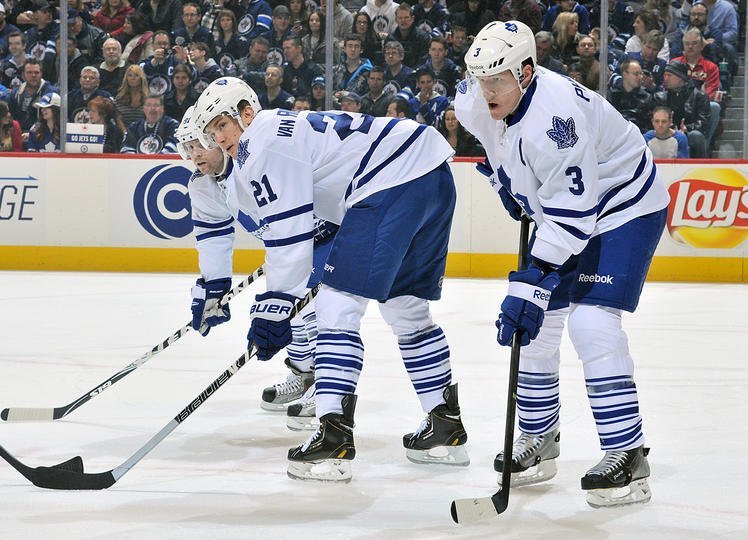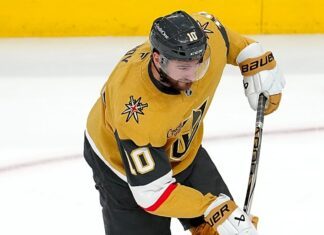Why is the Leafs‘ PK struggling so heavily?
Plus much more on the week that was in Leafland.
It’s kind of amazing how the Leafs‘ awful penalty kill has flown right under the radar this season.
Yeah, everyone knows it’s bad, but when it was bad under Ron Wilson there was a constant reminder of how bad it was. It was a cloud of negativity hanging over Wilson’s teams.
This season, though, it just doesn’t seem like it’s being made out to be nearly as big of a deal. But how bad is it? The current 76.8% success rate is a lower success rate than it was in the last year and a half under Wilson. And this is with the Leafs best goaltending in at least a decade.
If there’s one number that sums it up it’s the shot against per 60 minutes number: The Leafs allowed 41.8SA/60 minutes in 2012-13 compared to this season’s 61.7/60. Generally speaking I’m not huge on stats per 60 minutes, but that’s crazy. That’s a huge drop, and it can’t be ignored.
The Leafs were the most penalized team per game last season, but they were middle of the pack when it came to actual minor penalties (one being lowest and 30th being highest, they were 14th). This season, only the Jets, Sens, Kings and Flyers have more minor penalties, although it’s worth noting the Leafs do have a few games in hand on most teams.
It’s never just one thing when there is a drop this sudden and massive. It’s always a collection of factors that combine to contribute to such a precipitous drop.
The first is that the Leafs have suddenly fallen right off at winning faceoffs this season while shorthanded. Last season they won 51% of their shorthanded draws. This season? 43%. Bozak, in particular, killed it in the faceoff circle last season, winning 98 and losing 87. This season he has been horrible, winning only 34 and losing 62 (35%!).
That’s important because Bozak isn’t a great penalty killer. What made him effective last season was simply winning the draw, the Leafs icing it, and him getting off so Kulemin could get on. That’s 30 seconds gone right there.
That leads into really the most important drop off — in my mind, anyway — from last year to this one. Simply put: It is very easy to gain the zone on the Leafs penalty kill.
Powerplay units weave through the neutral zone and and set up with ease. The Leafs PK through the neutral zone just seems to take it and wait for the other team to get themselves set up. Look no further than the Leafs’ awesome power play – when it sets up, we know chances are coming and eventually a goal. The best penalty kills are the ones that don’t allow the other team to set up, but the Leafs defensemen wait a foot inside their own blue versus a foot outside their blue line and that gap allows teams to skate it in with ease.
For example, look at this PP goal by Frans Nielsen in a game against the Islanders earlier this month. Nielsen gains the zone without anyone remotely close to him as Franson and Kulemin are pretty well standing in front of each other in the middle of the ice. That’s just way too easy.
Skip to 1:54:
Of course, Wheeler had such a clean entry on Saturday he didn’t even need to setup as he walked right in and scored.
If a top power play unit can set up with ease, it’s going going to score, period. This the NHL in the salary cap era – every team can throw out five players who are capable of passing, shooting, and scoring.
The third difference I’ve noted is that the Leafs, to my eye, appear to be a lot more passive. It is really shown in the actions of the two forwards. Last season the forwards would swing from board-to-board; if the other team was in an umbrella and moving it from top left, to top center, to top right, one Leaf would follow the puck throughout that while the other would stay in the middle cutting off the pass (you might recall I titled it a “T” kill). This season the forwards have been much less aggressive, and the second guy isn’t cutting off the middle nearly good enough. On Adam Henrique’s goal on January 12, the puck traveled around and Jay McClement, who was at least a second late in trying to cut off the cross ice pass. Henrique is able to wind up and rip a wrist shot right by the goalie in a prime scoring position.
Skip to 1:27:
This past weekend the Jets scored a goal and PPP took a photo of the play where McClement isn’t even close to the puck carrier. Last season, the forward would be right on that guy making him unable to breathe. This season they have all day.
One of the biggest reasons the Leafs made the playoffs last season was their penalty kill. If they don’t make it this season, it will be one of the biggest reasons why they don’t.
–
Notes
– Many fans were upset the Leafs didn’t use a buyout on Liles instead of Grabovski or even Komisarek for cap purposes, but if Gleason continues to play this well it might work out okay. He’s played over 18 minutes in 8 of his 11 games with the Leafs, but the most important thing about Gleason is the stability he seems to provide throughout the defense. Due to Gleason being effective in his own zone, it has freed up Gardiner to play with Rielly (which has been awesome), and it’s allowed Phaneuf to get a few more offensive minutes. I don’t think it’s a coincidence the Leafs defense has been scoring a lot lately; Gleason has allowed the Leafs to use their offensive guys in offensive situations more often instead of asking them to play strictly defense all game.
– It’s also noteworthy that the coaching staff has begun using Gleason-Phaneuf to finish off close games. They were on together at the end of the Boston game and they were out in the final minute together against Winnipeg.
– Maybe it’s because he was in his hometown, but Carter Ashton had a great game against Winnipeg. Down 2-0, he single-handedly dominated a shift in the Jets zone creating numerous turnovers, getting physical, and creating a shot on net. That’s why it’s nice to have an effective fourth line, as that game was going south in a hurry and that shift kind of swung momentum in the game. Later on in the night, Ashton added an assist on Gleason’s goal.
– Troy Bodie scoring in that game is another example of depth being important. You can’t always look at Kessel and JVR to drag the team back and carry them, but that Jets game was a good example of other players pulling the Leafs close before the big guns completed the come back and earned a point. Kessel dominated that third period, but it probably doesn’t matter unless the depth cast of Bodie, Ashton and Gleason step up and contribute to get them within arms reach. This is why we don’t want pointless enforcers in the lineup.
– A few weeks ago, I noted the Devils not playing Cam Janssen against the Leafs, which I thought was strange because the Leafs were obviously dressing an enforcer. This weekend, CBC showed a clip of Thorburn giving it to Dion Phaneuf from the bench; the same Thorburn who got into three fights last season against the Leafs. Yet Orr and Thorburn were never close to fighting Saturday despite the team being down by a few and Thorburn opening his mouth. I’m not going to get into the “why is he even dressing if he won’t fight” conversation here. My point is more that teams aren’t engaging the Leafs like they did last season; the opponent can simply leave Orr alone, and it works to their advantage since he’s not fast enough to consistently inflict damage physically within gameplay. When will there be a moment where the coaching staff asks itself: If Orr’s not fighting, and teams don’t want to fight him, is it worth playing him?
– The nicest thing about the Leafs’ win streak to me was the team finally throwing pucks on net even when it wasn’t an obvious time to do so. Carl Gunnarsson scored a goal off a floater from Phaneuf against Phoenix, Gardiner floated in a puck from the blue line against Colorado that found its way into the net, and Gleason took a low one timer off the rush that went off a skate and in the net. Shoot the puck more and good things will happen.
– I went back and watched Pavelec on Kulemin’s breakaway attempt. He didn’t even flinch when Kulemin faked backhand. Eventually you have to change your move.
– Tough week to comment on the games when the teams lays an egg in Dallas, after going up early on Colorado and Phoenix and coasting with the lead.
– I really liked two strong plays leading to goals stemming from neutral zone play. The first was Rielly going D-to-D to Gardiner in the neutral zone and Gardiner receiving the puck with speed before passing it to Lupul, who got it in deep and maintained his speed while doing so. Dump and chase hockey can be effective, but it has to be done with speed and numbers. In this case, Troy Bodie and Lupul were able to get in there, create a turnover, and work it to the point, resulting in a goal. Far too often the Leafs get it in deep by either long stretch pass deflections, or by shooting it around the boards where the goalie can easily stop the puck and play it.
– The second resulted in Troy Bodie’s goal Saturday night. Rielly set up behind the net, Kadri wheeled low, and when he got the puck in the neutral zone he cut through and set up Bodie for a goal. Both of those goals have something in common: movement. The Leafs get into trouble when guys stand around the neutral zone looking to deflect pucks deep, but when they move their feet and attack as a unit they are very effective.
– Side note: Kadri’s cut in move worked that time. Sometimes it won’t and the other team might score as a result. These are risks you take with all these young guys (Rielly, Gardiner, etc.), but the best way to get these kids to grow is to allow them the freedom –within reason– to try things and learn from trial and error. This time it worked out for the Leafs.
–
Quotes
“We felt it would be the decision to let a guy play in his hometown… I contemplated whether to do something at that point [when Jets made it 2-0] but I felt get him through the period and give him an opportunity to fight and battle himself back.”
– Randy Carlyle, commenting on his mind-frame towards Reimer in the Jets game.
After the whole Detroit game incident, when Reimer was upset he was pulled and Bernier went on his run of play, I was worried Reimer was going to get the Cody Franson/Nazem Kadri-Ron Wilson treatment for opening his mouth. It sounds to me like Carlyle really is trying to get Reimer going.
“I don’t know what’s going on right now, but I’m making some poor decisions”
– Jake Gardiner, after his turnover led to the Avs second goal.
Gardiner is a great talent and he should be a part of the Leafs present and future, but he’s still a Jekyll and Hyde player. This third pairing role with Rielly is working great for him because he and Rielly can freely wheel against significantly-less-talented players and get away with it. Right now, that’s looking like the place for him to be even though, when he’s on, he could easily move up the defense and play more.
“When players aren’t being used like Ashton right now on the 4th line or Holland before him, management steps in and makes adjustments”
– Darren Dreger.
It shouldn’t have to come to this. Holland and Ashton are good young players capable of contributing. They should simply be playing and that’s that.
–
5 Things I Think I’d Do
1 – I think the bad PK needs more acknowledgement and some new things need to be tried in an attempt to fix it. Maybe they should just use a Marlie staple in Carter Ashton or recall Jerry D’Amigo and give him another shot at it. The PK is now second worst in the entire league and pretty well anytime a team gets a power play you get that feeling that they are going to score. Maybe finding a good penalty killer should be the goal of the trade deadline? That could be a reason why Friedman reported earlier this year that the Leafs poked around about Mike Weaver as he’s an excellent penalty killer.
2 – Conversely, the power play is great (currently ranked third in the league). It’s admittedly tough to nitpick such a strong unit, but I’m surprised that Gardiner hasn’t stuck on PP1 after the Bruins game. Ultimately, it’s tough to tell a coach to change something that’s working, but Gardiner-Phaneuf/Rielly-Franson puts a skater on each pairing and I’m not sure they lose much –if anything– by swapping Gardiner and Franson.
3 – When Clarkson returns, I think a bottom six of Raymond-Holland-Clarkson/Ashton-McClement-Bodie is a no-brainer. That said, I doubt we see it.
4 – I think, unless a deal that’s too good to be true falls into Nonis’ lap, it just doesn’t make any sense to trade Reimer right now. Bernier’s been good, but he hasn’t played this much since 2009-2010, so who knows how he’ll handle the increased workload down the stretch. Beyond that, while Reimer’s had a rough patch lately, he’s still a good goalie. I don’t think Reimer has much negotiating power with the Leafs this summer; unless they can move him and actually fill a hole, I’d be in favour of keeping him as of right now.
5 – I think, with the news of JVR and Kessel both playing banged up, the team needs to start trying to push Lupul up the line up whenever they can. Why? A) To try and get him going, and B) If he does get going, to take away some minutes from those two. We all know JVR and Kessel are going the Olympics, and the last thing this team can afford is those two getting burnt out for the stretch drive. The way this playoff race is looking, it could come down to the final week.































